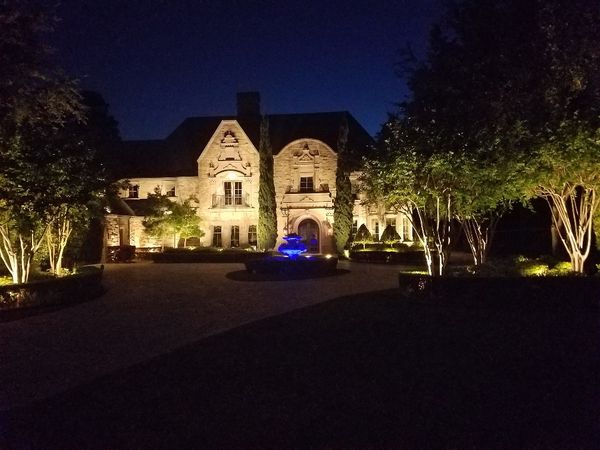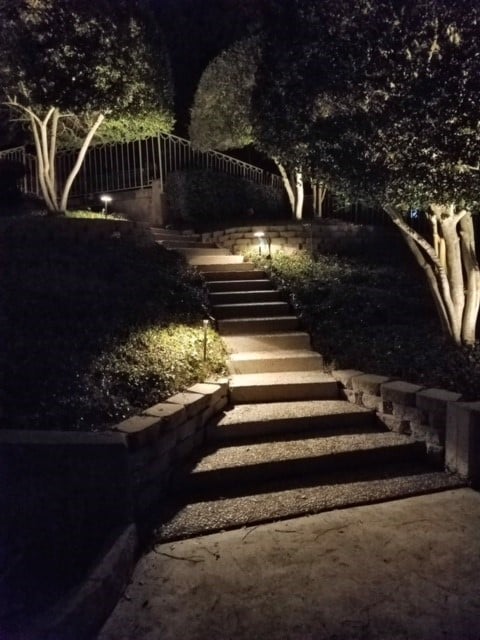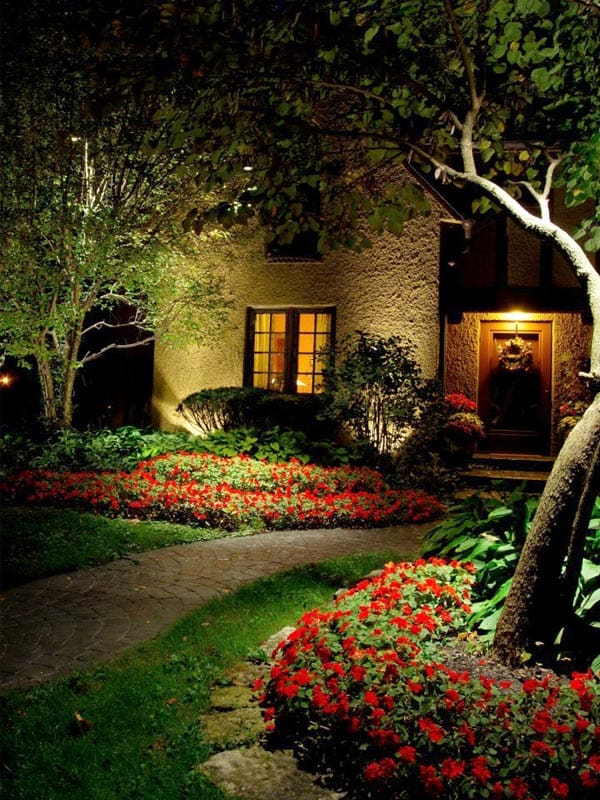
When adding lighting to your landscape, you must pay attention to both the small details and the big picture. Landscape lighting scenes and transitions are important parts of your landscape’s cohesion. How you illuminate one space affects nearby areas and vice versa. Landscape lighting isn’t just about how your landscape looks but also how it feels.
This may seem a bit overwhelming, but Creative Nightscapes is here to help make sense of outdoor lighting design and explain how to make it work for you. We will break down how lighting scenes and transitions impact the look of your property and how to use different lighting techniques to create a unified masterpiece.
Working with a skilled professional lets you get the most out of your outdoor lighting.
What Exactly Are Landscape Lighting Scenes and Transitions?
In landscape lighting, a scene refers to a particular area. These scenes can be places like patios or gardens. The transition refers to the change that occurs between scenes.
A scene does not exist in a vacuum. For example, walking through a low-light area of your yard directly into a brightly lit space can be jarring and strain your eyes.
You can prevent abrupt shifts in lighting between scenes by creating smooth, gradual transitions. Think about how your eyes need time to adapt to changes in light, like when you enter a dark room after being outside on a sunny day. Design your outdoor lighting so your eyes don’t have to fight to adjust.
Warm Welcome
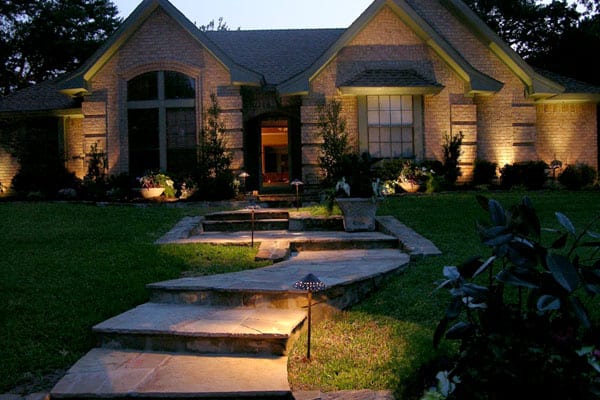
After a long day at work, a welcoming home is a comforting sight. You can use landscape lighting to achieve that feeling of invitation and warmth. In the following segment, we’ll explain how to combine patio, path, and driveway lighting to create a warm welcome for yourself and your visitors.
To create a warm welcome, you’ll have to find the ideal amount of light for the area light. Without enough light, it may be hard to see where you’re going and interfere with what you want to showcase in the scene. However, too much light can make it difficult to see and distract from your landscaping.
How Do I Use Patio Lighting to Make My Home Welcoming?
Walking onto a dark patio at night can seem intimidating and pose a tripping hazard! On the other hand, a patio filled with overpowering light can hurt your eyes, make it hard to see, and seem off-putting. If your patio is far out in your yard, path lights are a great way to assist in a smooth lighting transition. You may need to consider the brightness of existing wall lights if your patio is close to your house.
How Do I Create a Warm Welcome with Path Lighting?
Path lighting doesn’t only serve to reveal tripping hazards; it can also create an inviting feeling when approaching your house or patio. Darkness can cause fear and uncertainty, while outdoor lighting can bring feelings of relaxation. Path lighting is also helpful for creating transitions between scenes.
How Do I Use Driveway Lighting to Make My Home More Welcoming?
Like other types of outdoor lighting, driveway lighting has both cosmetic and practical uses. It alerts drivers to the edges of your driveway and creates a great first impression.
You may need to consider surrounding light sources when designing your driveway lighting. Depending on where you live, there may be light from streetlights, or if you live somewhere rural, there may be no light at all. If your driveway lighting is too bright or too low for your area, it can be difficult to navigate and spot potential hazards in the driveway.
How Do I Use Step Lighting in My Landscaping?
Step lighting is another addition where you need to pay attention to the amount of light you use. The main purpose of step lighting is to reduce the likelihood of people tripping when going up and down stairs. However, too much light can make it hard to see the steps. If you have pathway lights leading to your stair lights, create a smooth transition between them so the light is not overwhelming. You can blend them to form a continuous path of light.
How Do I Use Garden Lighting in My Landscaping?
Garden lighting has several variables to consider when planning your design. Garden lights can be close to a house or by themselves in a yard. Consider the level of brightness needed for the placement. Overly bright lights in a remote part of your yard can create a distraction instead of highlighting the beauty of your garden. If your garden is close to your house, you may need to account for wall lighting to avoid overpowering the space.
Techniques of Outdoor Lighting
You can use various outdoor lighting techniques to create memorable scenes and gorgeous transitions in your landscape. There are different light fixtures you can use to suit different techniques.
Uplighting
Uplighting is where a light is shined upward on an object. This object could be a tree, plant, or architectural feature. It is great for setting the scene around a statue or tree.
Niche Lighting
Niche lighting is when a light is placed in a recessed or hard-to-reach area. You can illuminate scenes like entryways, decks, and gazebos with niche lighting.
Mirror Lighting
Mirror lighting uses light to reflect the image of an object off the surface of water. You position the light between the object and water to reflect the image. Mirror lighting can add a majestic look to scenes. Avoid using downlighting for this, as it can cause glare.
Cross Lighting
Cross lighting aims to define a surface’s shape and texture using multiple light sources instead of flattening it with a single light source. Cross lighting highlights an object’s features and emphasizes its place in a scene.
Wall Lighting
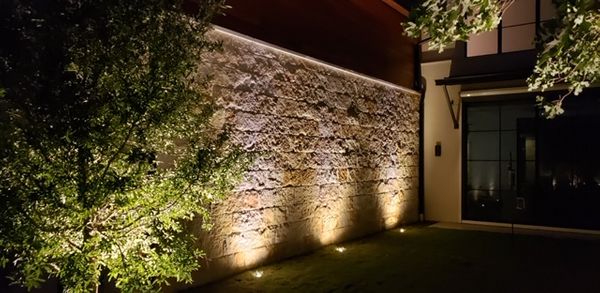
Wall lighting is used to illuminate retaining and free-standing walls. It is a fantastic way to bring your home into a scene. By positioning wall lights strategically, you can also create a transition between scenes.
Path/Area Lighting
Path lighting doesn’t just alert people to potential tripping hazards; it is also a great way to transition between scenes. Given the nature of path lighting, it can connect scenes that are farther apart, creating a sense of unity across your landscape.
Shadowing
Shadowing involves shining a light on an object, such as a plant or statue, to cast a shadow on a nearby wall. Shadowing can be used on vinyl siding to break up its monotonous pattern. It is a fun way to add intrigue or drama to a scene.
Grazing
Grazing uses a light against a surface to make asymmetrical patterns and broken shadows on brick walls, stucco, stone, and tree trunks. Grazing draws the eye in and can make a scene more memorable.
Backlighting
Backlighting highlights the edges of an object to showcase its shape. Objects with unique shapes are good subjects for backlighting. Backlighting is an excellent way to incorporate large tree trunks and small, conical trees into a scene.
Downlighting
Downlighting involves shining a high-mounted light downward to illuminate wide areas. You can use downlighting to create a transition between scenes.
Moonlighting
Moonlighting, a form of downlighting, projects soft, natural light onto a large area. Moonlighting fixtures are placed in trees, and a good way to describe moonlighting is “downlighting using a tree.” Like path lighting, moonlighting is a helpful tool when creating transitional light between scenes. It can illuminate dark spaces on your landscape. Since moonlighting depends on the placement of trees, you may have fewer places to use them for transitions.
Please note: When attaching lighting to a tree canopy, be sure not to screw the canopy directly to the surface of the tree, as this can cause tree rot. Leave space between the canopy and the tree.
Outdoor Lighting in North Richland Hills, Texas
If you’re overwhelmed by the myriad lighting options available, there’s no need to worry. That’s where we come in. If you’re in the Dallas-Fort Worth area, our team can create a beautiful outdoor lighting setup to enhance the beauty of your property. Since 2004, Creative Nightscapes has been helping people create gorgeous works of art with outdoor lighting. We’ve won multiple awards and proudly maintain an A+ rating with the Better Business Bureau.
Contact us for a free outdoor lighting consultation and quote.


